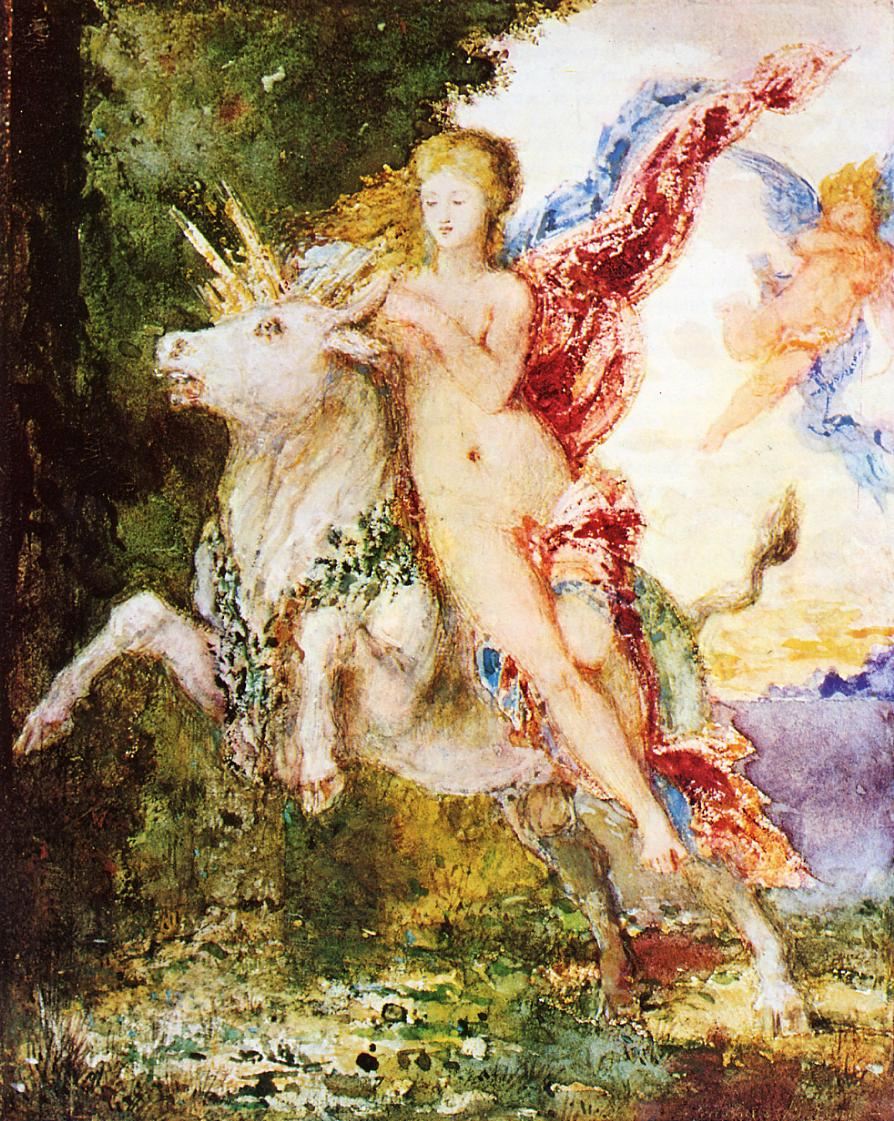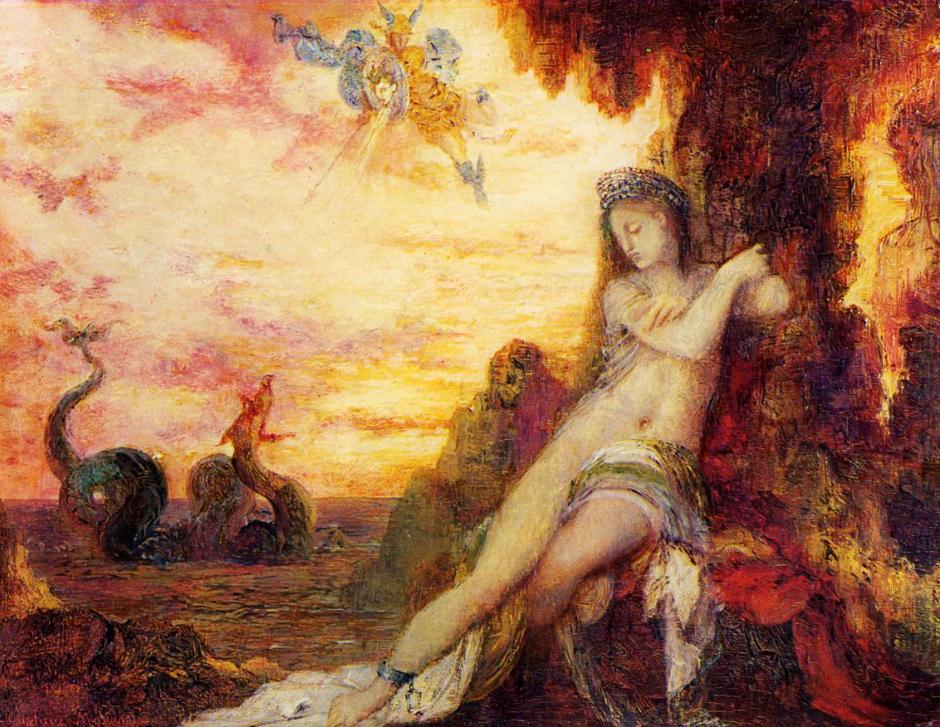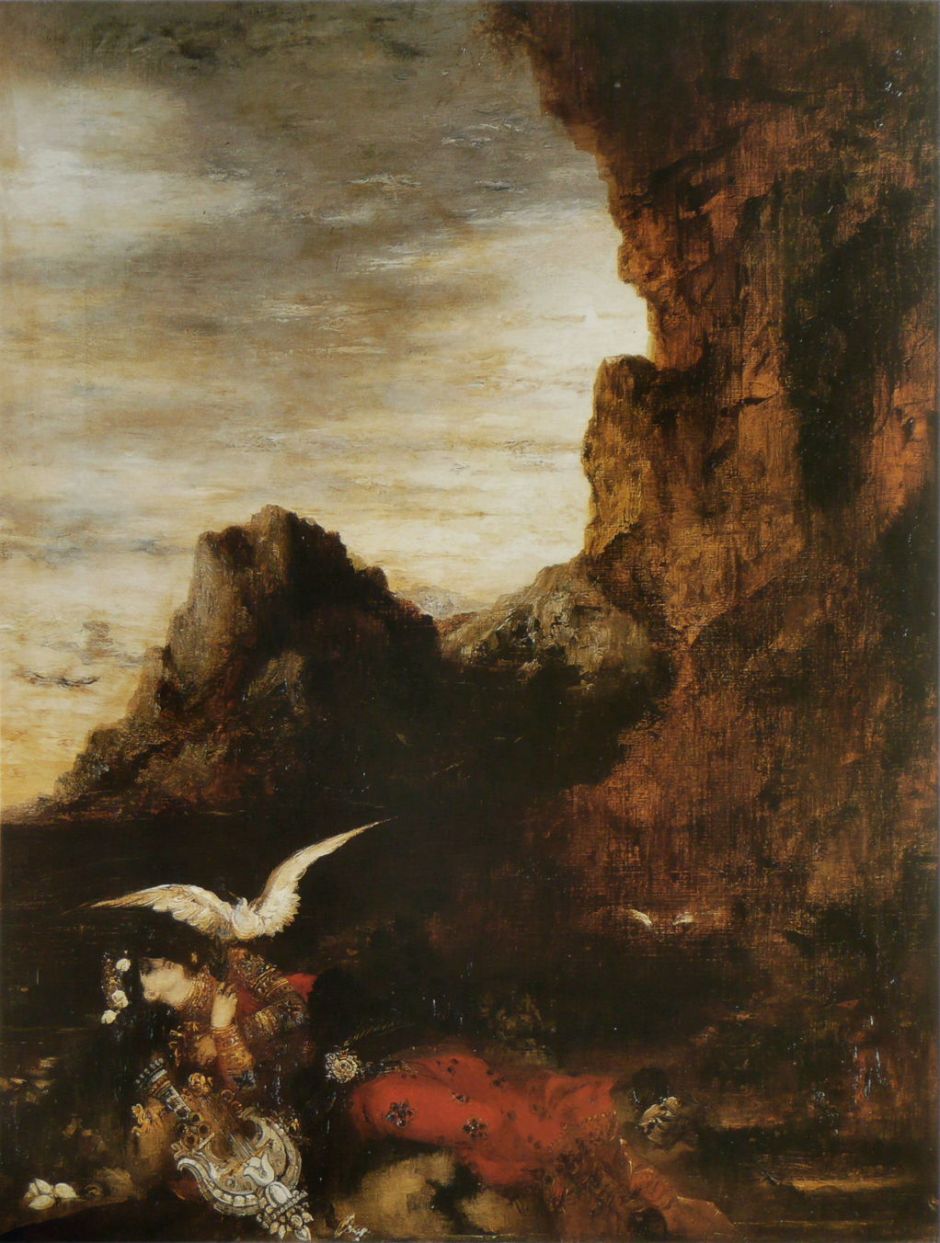In 1867, two of Gustave Moreau’s paintings were shown at the Exposition Universelle: Orpheus and The Young Man and Death. Neither won any awards or recognition there, so he pressed on preparing his submissions for the Salons of 1868 and 1869, still hoping to repeat the success of his Oedipus and the Sphinx.

Moreau still produced the occasional religious painting. His Pietà (Descent from the Cross) from this time reworks that from more than a decade earlier, remaining dark and quite unlike his brighter and more ornate history paintings.

The Chimera (1867) was the first of several paintings after Oedipus and the Sphinx to consider odd semi-human mythological creatures.
The original Chimera was a Greek mythological beast, a fire-breathing monster in Lycia, Asia Minor, which consisted of body parts from several different species. Although opinions varied, the popular depiction of the Chimera in classical art was of a lion with the head and neck of a goat rising from its back, and a tail which ended with a serpent’s head. It was finally slain from the air by Bellerophon, riding Pegasus, the winged horse.
Moreau’s creature, itself a chimera, consists of a centaur with wings, or the torso and head of a human, the wings of an eagle, and the body and legs of a hirsute horse. The only mythological creature which conforms to this description is an Al-Buraq, from Islamic mythology in Persia. Although Moreau may have come across the Buraq, this is most probably an invention of his own.
Someone aware of the story of Bellerophon, Pegasus, and the Chimera might assume that this painting somehow relates to that myth. This creature is not Chimera, or a Pegasus-like beast, nor does it show Bellerophon mounting Pegasus in quest for the Chimera. Instead it explores what appears to be a very erotic relationship between a young woman and a curiously androgynous creature, which is both surprised, and about to take off, risking losing her into the abyss below.

Although it may be from as late as 1880, some date The Voices (or Hesiod and the Muse) to 1867. A small jewel of a watercolour, this revisits what was to become one of Moreau’s favourite motifs, originating with his earlier Hesiod and the Muses (1860). On this occasion there is but one muse, who is winged and bears a golden laurel wreath ready to crown the young Hesiod, who still bears his shepherd’s crook.

The muses and their encouragement of the arts is also the theme of another painting from this time. Moreau started work on The Muses Leave Apollo, their Father, in Order to go Forth and Enlighten the World by 1868, but abandoned it shortly afterwards. In 1882, he took it up again, had its canvas enlarged, and extended the painting before abandoning it again.
Its narrative is extremely simple, and related in its title: the Muses, of epic poetry, lyric poetry, history, song, tragedy, hymns, dance, comedy, and astronomy, are shown leaving Apollo (son of Zeus, who was generally held to be their father) to bring inspiration to the human world. Judging by the lines showing where the canvas was extended, this originally consisted of little more than Zeus, sat on his throne, with the Muses close-packed in front of him.
The painting is now quite ornate, with extensive decorative elements in the clothing, and even covering the figure of Zeus, but it is not clear how much of that was added after the canvas had been extended.

Prometheus (1868-9) was one of the two paintings which he exhibited at the Salon in 1869, and follows on from the classical narrative of Moreau’s Diomedes.
The story of Prometheus is mostly given in Hesiod’s Theogony. He was a Titan (a parent of the gods) who tried to challenge Zeus’ omnipotence in several different ways. Originally, humans knew fire and how to use it, but Zeus withdrew it from them. Prometheus stole fire from the gods, carrying it in the stalk of a giant fennel plant, to return it to humans. This enraged Zeus, who punished mankind by sending Pandora, the first woman, to live with man, complete with her notorious jar or box.
Prometheus was then punished by being chained to a rock in the mountains, traditionally those of the Caucasus, where an eagle visited him daily to eat from his liver. Because he is immortal, each night his liver regenerated for the bird to feed on the following day. Eventually, Heracles (Hercules) killed the eagle and freed Prometheus from his torment.
In Romantic literature, the story of Prometheus had been used as an analogy for that of the persecuted artist, who takes their great gift to man, only to end up being tortured horribly for doing so. Read superficially as narrative, Prometheus’s impassive face reflects his stoicism in the face of the vulture feeding from his liver. Above his head is a flame, signifying the gift that he provided mankind. A second, dead vulture indicates the perpetuity for which Prometheus will suffer, at least until Heracles intervenes.
Moreau’s daring depiction, though, calls on symbols of Christ’s suffering: the appearance of Prometheus is messianic, he adopts a posture which is reminiscent of the flagellation of Christ, and above all, the flame could represent the Holy Spirit.

Europa and the Bull (c 1869) is a watercolour study for the second of his works for the Salon in 1869.
Europa’s abduction is one of the most frequently-painted stories from Greek mythology. She was the mother of King Minos of Crete, and the story of Cretan origin; the bull was the main sacred animal in Crete. Zeus (Jupiter to the Romans), a notorious ravisher of women, lusted after the beautiful Europa. He therefore metamorphosed himself into a white bull, and hid among Europa’s father’s herd in Phoenicia. When Europa and other maidens came to gather flowers near this herd, she saw the white bull, caressed it, and climbed onto its back.
Zeus then ran to the sea and swam with Europa on his back until they reached the shores of Crete. There he revealed himself, and Europa became the first queen of the island. He gave her in return a necklace, Talos (a giant bronze automaton who protected Crete by circling its shores), Laelaps (an unfailing hunting dog), and a javelin which always struck its target.
Almost universally, previous depictions of this myth have shown the start of the abduction, from the pastures of Phoenicia to the bull heading off to sea. Moreau’s white bull, with Europa riding a precarious side-saddle, here seems to have just emerged from the sea, so is presumably now on the island of Crete.

The finished work, known as Jupiter and Europa (1868-9) (I apologise for the lack of sharpness in this image) but titled Europa, shows the bull with a human head, presumably as Zeus has revealed himself to Europa. The head of Zeus recalls those of sculptures of Assyrian kings.
It’s hard to see what Moreau brought in terms of originality to this well-worn motif, and the critics drew comparison with Veronese rather than Titian. Either way, this seems to be a painting in search of a reason.
Moreau had now received three medals from his work shown at the Salon, and qualified for the Legion of Honour, and to exhibit further work without the need for acceptance by the jury. However, he had not received any favourable criticism since Oedipus and the Sphinx in 1864. There was now a small but dedicated group of collectors who – whatever happened in the Salon – were prepared to purchase his paintings. Accordingly, he decided not to exhibit at the annual Salon any more.

Moreau seems to have completed at least two more paintings before the autumn of 1870. One was another version of Hesiod and the Muses (1870), although there is again just a solitary winged muse sat with Hesiod, who appears to be in danger of slipping off this rock in the harbour below.

Moreau’s magnificent Perseus and Andromeda (1870) is perhaps his greatest achievement of the period just before the war. Although it is presented in his distinctive style, with very high-chroma colours and decorative passages, he has again followed fairly traditional techniques of history painting.
Andromeda, seen in the foreground, has been shackled to a rock as a human sacrifice to the sea monster Cetus, who has been laying waste to her father’s kingdom. Just as Cetus arrives to enjoy this most beautiful of victims, Perseus arrives to kill the monster, rescue the beautiful woman, and then to marry her. As I detailed elsewhere, Moreau is one of the few artists to have adhered to the original story. Most show Perseus astride Pegasus, but according to the original textual account he came on his winged sandals, bearing the polished shield which still shows the image of Medusa’s head, as seen here.
Andromeda’s face is perhaps a little too expressionless: she may be resigned to her fate and have not yet spotted Perseus, but even she should have shown some trepidation at the arrival of Cetus. Moreau’s timing is classical, in that he hits the exact moment of dramatic climax, and shows explicit peripeteia. He may have avoided showing theatrical action, but there is nothing amiss with his narrative technique.

The Death of Sappho was probably in progress when the Franco-Prussian War broke out, and was not completed until after order was restored to Paris the following year. It shows the terminal scene in the legendary biography of the great Greek poet Sappho, according to Menander, moments after she had thrown herself of the Leucadian cliffs for the love of a ferryman, Phaon. Her body lies in peaceful repose, her lyre beside her, and a seagull in mourning. The contrast between the elaborate decoration of her body, clothing, and lyre and the stark rocks and gloomy sea and sky could not be greater.
Although since the twentieth century Sappho has been a figurehead of lesbian love, in the seventeenth century she was identified with heterosexual relationships. I do not know whether Moreau associated her particularly with either, and suspect that he viewed her more as a great – if almost lost – poet, rather than in any sexual sense.
Sappho was to become another recurring theme in Moreau’s paintings. She is another symbol of the persecuted artist, but equally at this time could have been a response to Moreau’s experiences in the war.
He had joined the National Guard, and served in the defence of Paris in the autumn of 1870, beseiged with his mother. During the winter, his left shoulder and arm had become immobile because of ‘rheumatism’, but he remained in the city. Finally, during the Commune in the spring of 1871, he defended the paintings which he had amassed in his home, and watched his late friend Chassériau’s murals in the Cour des Comptes be destroyed by fire.
He spent the summer of 1871 recovering, with his mother, in the spa at Néris-les-Bains in the Auvergne. By 1872 he was ready to resume his painting, and to find his form at last.
References
Cooke P (2014) Gustave Moreau, History Painting, Spirituality and Symbolism, Yale UP. ISBN 978 0 300 20433 9.
Mathieu P-L (1998, 2010) Gustave Moreau, the Assembler of Dreams, PocheCouleur. ISBN 978 2 867 70194 8.

